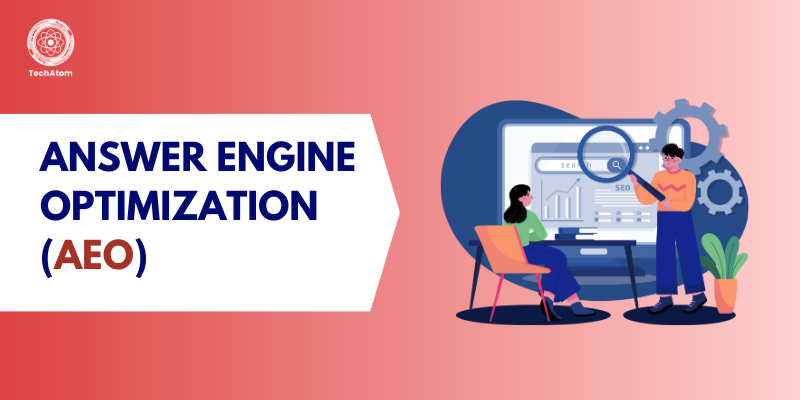Search is changing faster than ever. Just a few years ago, most people typed short keywords into Google and scrolled through blue links. Today, AI-powered tools like Google’s Search Generative Experience (SGE), Bing Copilot, and ChatGPT are answering questions directly, often without users ever clicking on a website.
This shift has created a new reality for businesses: getting visibility now means more than just ranking webpages. You need your answers to show up inside AI-generated responses. That’s where Answer Engine Optimization (AEO) comes in.
In simple terms, AEO is about optimizing your content to rank as an answer in AI-driven search engines. While SEO focuses on keywords and backlinks, AEO focuses on intent, context, and structured answers.
As 2025 unfolds, AEO is no longer optional. With zero-click searches rising and users relying more on voice assistants and AI summaries, brands that adapt early will stay visible. Those that don’t risk becoming invisible in the age of answer-first search.
What is Answer Engine Optimization (AEO)?
Answer Engine Optimization (AEO) is the process of making your content discoverable and usable by AI-powered search systems that deliver direct answers. Instead of just optimizing for traditional search rankings, AEO helps your content appear inside results generated by Google SGE, Bing Copilot, ChatGPT, Perplexity, and other emerging “answer engines.”
The big difference is intent over keywords. Traditional search engines matched queries with indexed pages. Answer engines analyze natural language queries and pull the most relevant, concise answers.
For example:
- In Google, searching “best laptop for students 2025” might show you 10 links.
- In ChatGPT or SGE, the same query generates a summarized list of laptops, often sourced from multiple websites.
That means businesses must optimize for answers instead of just links. AEO involves structuring content clearly, providing direct explanations, and adding schema markup so AI systems can understand context.
AI is transforming search from “find me a page” to “give me the answer.” AEO is how you stay visible in that shift.
Why AEO Matters in 2025
In 2025, most users don’t want to dig through dozens of pages. They want instant, trustworthy answers. AI assistants, voice devices, and conversational search engines are designed for exactly that.
A few trends explain why AEO is essential now:
- Voice search is mainstream: People ask Siri, Alexa, and Google Assistant complete questions, not keywords.
- Zero-click searches are growing: Studies show over 50% of searches end without a website click because users get answers directly on the results page.
- AI assistants are sticky: Users are more likely to trust concise AI answers than long web pages.
For businesses, this means your website might not get the same clicks it used to, but if your content powers AI answers, you still win visibility, trust, and traffic. In other words, AEO is the future of organic reach.
SEO vs AEO – Key Differences
While SEO and AEO overlap, they focus on different outcomes:
|
Aspect |
SEO |
AEO |
|
Goal |
Rank web pages in search engines |
Rank answers in AI-driven systems |
|
Focus |
Keywords, backlinks, site authority |
Search intent, structured answers, context |
|
Output |
List of links |
Direct answers/snippets |
|
Techniques |
On-page SEO, link building, and content depth |
Schema markup, FAQ content, conversational queries |
|
Example |
Blog ranking on Google’s first page |
Content cited in Bing Copilot’s answer |
Businesses shouldn’t choose one over the other. The smartest strategy in 2025 is blending both: SEO brings traffic, AEO brings visibility in AI-first experiences.
How Answer Engines Work
Answer engines combine natural language processing, large language models (LLMs), and knowledge graphs. When you ask a question, they:
- Interpret intent – What exactly are you asking?
- Retrieve data – Pull from indexed web pages, structured data, and databases.
- Generate answers – Summarize results in natural, conversational language.
- Cite sources – (Sometimes) show where the information came from.
Unlike traditional search, answer engines don’t just match keywords. They try to understand why you asked and deliver a useful response — which is why content must be optimized differently.
Core Elements of AEO
- Search Intent Understanding
Write content that directly answers questions (“what,” “how,” “why,” “which”) rather than just listing keywords.
- Structured Data & Schema Markup
Use FAQ schema, How-To schema, and product markup so engines can easily parse answers.
- Content Relevance & Context
Keep answers concise but provide context around them for credibility.
4.Authority & Trust Signals (E-E-A-T)
Cite reliable sources, add author bios, and demonstrate expertise to build trust.
- Conversational & FAQ-style Content
AI engines favor question-and-answer formatting.
- Voice Search Optimization
Optimize for natural, spoken queries like “What’s the cheapest CRM for small businesses?”
Strategies to Optimize for AEO
Here are simple strategies you can use to optimize for AEO:
- Create answer-first content: Start sections with direct, 1–2 sentence answers before elaborating.
- Use question-based H2s/H3s: Format like “What is AEO?” or “Why does AEO matter in 2025?”
- Implement schema markup: Add FAQ, How-To, and Product schema for machine readability.
- Build topical clusters: Connect pillar pages with related subpages to signal authority.
- Optimize for voice queries: Include conversational phrasing in content.
- Ensure mobile-first design: Fast-loading, responsive sites are prioritized.
- Add citations and sources: AI engines reward content that references credible data.
Examples of AEO in Action
- Google featured snippets: The classic precursor to AEO — short answers pulled into the search page.
- Bing Copilot / ChatGPT: Generates summarized answers by citing multiple websites.
- Case studies: Brands that create FAQ hubs or knowledge-based content often see their answers reused in AI search responses.
- SEO vs AEO blog difference: An SEO blog might rank with keywords like “best laptops 2025.” An AEO blog would include an H2 “What is the best laptop for students in 2025?” followed by a direct, bulleted answer.
Tools and Techniques for AEO
- SEMrush, Ahrefs, SurferSEO - Keyword + intent analysis.
- Schema.org - For structured markup.
- Google SGE insights - Track how your content shows up in experimental AI results.
- AI content tools - Help identify question-based queries and conversational keywords.
Challenges & Limitations of AEO
- Accuracy and bias: AI may generate wrong or biased answers.
- Traffic loss: Direct answers reduce clicks to websites.
- High competition: Limited spots for answers compared to SEO rankings.
- Balance issue: You can’t ignore SEO; both strategies must work together.
Future of AEO
In the next five years, expect:
- AI-first engines becoming the default way users search.
- Integration with AR/VR assistants.
- Hybrid SEO + AEO strategies becoming standard for businesses.
- Companies competing less for rankings and more for answer ownership.
Conclusion
Search in 2025 is about answers, not links. Answer Engine Optimization (AEO) is how businesses stay visible as AI reshapes discovery. While SEO still matters for traffic, AEO ensures your brand is present in voice queries, AI summaries, and conversational search results.
The takeaway is simple: optimize for both. Build strong SEO foundations, then adapt your content for intent, context, and structured answers. The businesses that master AEO today will be the ones users trust tomorrow.
FAQs
1. How is AEO different from SEO?
SEO focuses on ranking web pages. AEO focuses on ranking answers in AI-powered search engines.
2. Why is AEO important in 2025?
Because more users rely on AI assistants and zero-click searches, AEO keeps your brand visible.
3. How do AI-powered answer engines work?
They interpret intent, retrieve relevant data, and generate conversational answers, often citing sources.
4. What is the relationship between AEO and voice search?
Voice queries are conversational. Optimizing for AEO also helps content appear in voice search results.
5. What are the main challenges of AEO?
Accuracy of AI answers, reduced traffic from zero-click searches, and limited answer spots.
6. Will AEO replace traditional SEO?
Not completely. SEO and AEO work together. SEO drives traffic, AEO drives visibility in AI-driven search.

